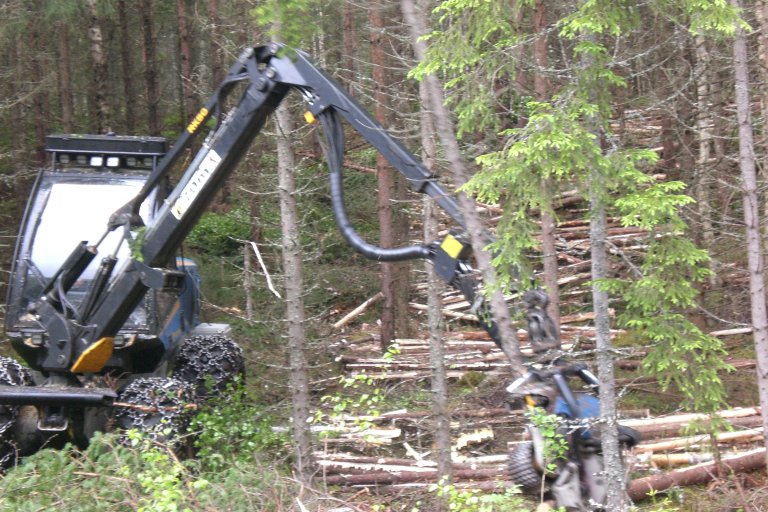Tynning og skogproduksjon

Formålet med tynning i skog er primært å flytte produksjonen over på de beste trærne jevnt fordelt på arealet og på det treslaget som er best egnet på stedet, slik at trærne får en optimal verdiproduksjon.
Tynning øker kvaliteten
Hyppighet og metoder
Hvorfor tynne?
Skiftende anbefalinger
Tynning og klimaendringer
Behovet for en aktiv skogbehandling (ungskogpleie og/eller tynning) vil antagelig være større i et fremtidig endret klima, siden dagens skog som er tilpasset små og langsomme klimaendringer over flere hundre år da blir stresset utover normalen. Vanligvis vil tynning med en reduksjon av tettheten og uttak av svake trær forsterke de gjenstående trærne. Et høyt tynningsuttak kan imidlertid øke risikoen for stormskader, mens ikke å tynne også gir risiko. I et endret klima bør antagelig tynning utføres ved et litt tidligere tidspunkt, og i vindutsatte områder bør man i enda sterkere grad utføre behandling/inngrep tidligere.
Litteratur
Øyen, B.-H. 2001. Langsiktige effekter etter tynning i plantefelt med sitkagran (Picea sitchensis Bong. Carr.) i Vest-Norge. Rapport fra skogforskningen 11/01.
Lenker
Skogkurs resymé nr. 6

Publikasjoner
Sammendrag
Det er ikke registrert sammendrag
Sammendrag
The relative volume growth effects of thinning after whole-tree harvesting (WTH) compared to a conventional stem-only harvest (CH) in young stands of Scots pine (Pinus sylvestris L.) and Norway spruce (Picea abies (L.) Karst.) were analyzed, using a series of four pine and four spruce field experiments. The series was established in the years 1972–1977, and thinning was performed only once. Results are shown periodically and cumulatively. All sites were included for 20 (19) years in pine and 25 years in spruce. The total experimental period varied between 19 and 35 years for individual sites. Four models assuming additive or multiplicative effects gave only slightly varying results. The inclusion of standing volume after thinning as a covariate was effective in spruce independent of whether the covariate was treated as multiplicative or additive. A logarithmic model with a multiplicative effect of the covariate was preferred in further presentations. Results for pine stands after 20 years indicated a nonsignificant loss of 5% with confidence limits (p = 0.05) of ±6–7%, while the spruce stands showed a significant growth loss of 11% with confidence limits of ±4–5% after 25 years. The difference between the species in relative growth effects was significant, and amounted to 8% for a cumulative 20-year period. No indications of trends in response were found during a 20-year period in pine and a 25-year period in spruce. An analysis of growth effects in the first years showed that basal area increment in spruce was significantly reduced already in the first growing season after thinning.
Sammendrag
Det er ikke registrert sammendrag
Forfattere
Petter Nilsen Line Tau StrandSammendrag
The present paper deals with C and N storage in soil and vegetation, litter fall and CO2 efflux from the soil 32-33 years after early thinning in a Norway spruce (Picea abies (L.) Karst.) stand in order to evaluate the effect of thinning regime on C sequestration. At 22 years old, the stand was reduced from 3190 to 2070, 1100 and 820 trees per hectare in four replicates. The N2070 treatment represents the recommended start density in practical forestry, while the other represent a moderate to large reduction in tree number at the present stand age. Aboveground biomass was estimated from single tree measurements of diameter and height based on allometric functions. Litter fall was collected during one and a half years and soil respiration was measured on five occasions during one summer. Ground vegetation was mapped and sampled for biomass, C and N determination. A significant decrease in aboveground tree (including stump-root system) C storage of 27% and 22% due to thinning was found in the N820 and N1100 treatments, respectively, compared to the N2070 treatment. Ground vegetation C storage was little affected by treatment, while litter fall C showed a non-significant decrease in the N820 and N1100 treatments compared to the N2070 treatment. Soil respiration was significantly lower in parts of the summer in the N2070 treatment compared to the N820 treatment. The reason for this is still unexplained since no differences in soil temperature, soil moisture or litter fall chemistry was found between the treatments. No significant treatment effects on humus and mineral soil C storage could be detected. With the present soil variability, the time period of 32 years is probably too short to detect soil C differences due to thinning. The N storage followed the same pattern as for C. (C) 2008 Elsevier B.V. All rights reserved.
